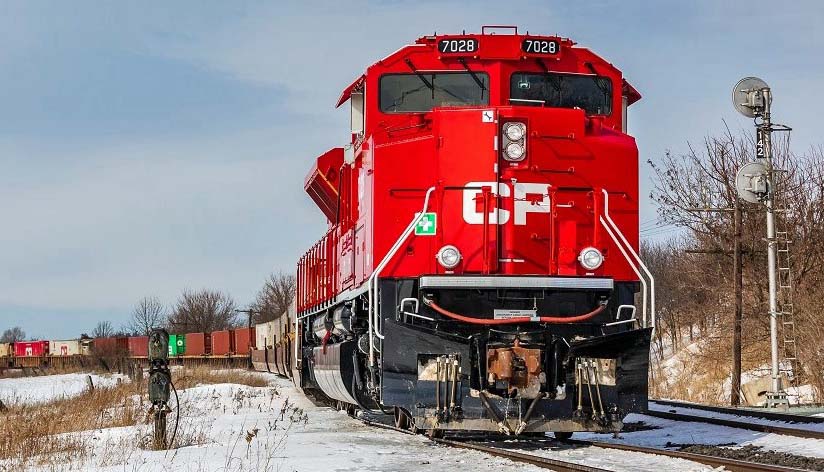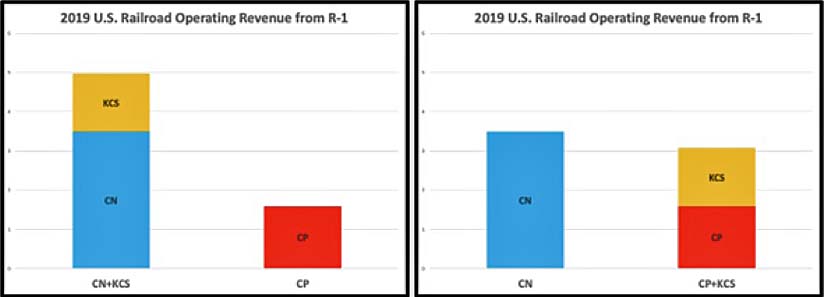
Calgary Alberta - Canadian Pacific Railway Limited (CP) yesterday filed a formal objection with the Surface Transportation Board (STB)
stating that Canadian National (CN) does not qualify for a waiver of the STB's rules for major transactions with respect to CN's unsolicited proposal for
Kansas City Southern (KCS).
In its letter, CP explains that the CN/KCS transaction does not satisfy any of the criteria that the STB relied upon in finding that the waiver should apply to
CP/KCS transaction, which the STB granted to CP on 23 Apr 2021.
The submission outlined the following reasons why a waiver should be rejected for CN's proposal:
1. CN is a much larger railroad than CP.
A combined CN/KCS would greatly expand the size of the fifth largest U.S. Class 1 railroad, vastly increasing the gap between CN/KCS and the new smallest
Class 1, which would be CP.
A combined CN/KCS would be more than three-times the size of CP, whereas the proposed CP/KCS would still be 13 percent smaller than CN (as measured by U.S.
operating revenue).

2. A potential CN/KCS combination heavily overlaps across much of KCS' U.S. system, unlike a CP/KCS combination.
A CN/KCS transaction plainly flunks the "end-to-end" test, notwithstanding CN's occasional and misleading assertions that such a transaction would be
end-to-end.
As explained in CP's 27 Apr 2021 letter filed with the STB, economic analysis of Waybill Sample data identifies a significant number of origin-destination
corridors where the number of independent rail competitors will be reduced from 2-to-1 or 3-to-2 by the CN/KCS transaction.
The verified statement of economist W. Robert Majure was filed with CP's submission and explains the screening analysis that confirmed these impacts and also
confirmed that CP/KCS is in fact end-to-end.
3. The potential downstream impacts of a CN transaction are material.
Whereas CP/KCS preserves the basic six-carrier structure of the North American rail network (two in the East, two in the West, and two in Canada with routes to
the Gulf), the CN/KCS transaction would destabilize that structure.
To borrow CN's own words, unlike CP/KCS, the CN/KCS transaction would be a "significant restructuring of the rail industry," and the Board needs the
new rules to address the "likely strategic responses."
4. CN's acquisition premium should cause the STB concern.
The extraordinary premium price CN is offering to try to disrupt CP's proposed combination with KCS ought to concern the STB, as it will not only extinguish
the new competition that a CP/KCS combination would bring to CN but also require CN to find ways to recoup those extra costs.
All of these consequences would arise immediately upon KCS being placed into trust as part of a CN acquisition, and the "public interest" standard of
the Board's 2001 rules should be applied.
5. CN's proposal to acquire KCS would kill the CP/KCS combination and all the pro-competitive effects that go with it.
The STB stated in its 23 Apr 2021 filing that it was applying the pre-2001 rules to the proposed CP/KCS transaction because that transaction "falls neatly
into the Board's rationale for adopting the waiver in the first instance."
The decision emphasized the "CP and KCS networks would appear to result in the fewest overlapping routes when compared to a merger between KCS and any
other Class 1 carrier".
Unlike the "end-to-end" CP/KCS transaction, after which the combined company would still be the smallest Class 1 railroad, the CN/KCS proposal raises
all of the concerns that the 2001 rules were adopted to address.
6. CN has already committed itself to the new merger rules.
Despite CN stating that its merger application would proceed under the current (2001) rules for major mergers, CN has also implied that its embrace of the 2001
rules was only "voluntary", perhaps suggesting that the STB would lack authority to bind CN to compliance with those rules.
That is another reason to make it official that the waiver does not apply and the new rules will govern.
Author unknown.
(because there was no image with original article)
(usually because it's been seen before)
provisions in Section 29 of the Canadian
Copyright Modernization Act.

